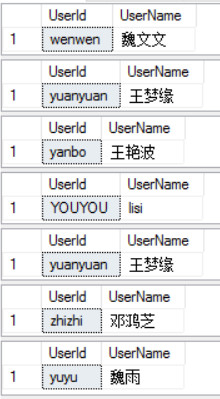
SQL游標的用法有哪些?
在眾多數據庫中, SQL游標是很多人用的比較多的。但是對于一些接觸數據較少的人來說,他們不知道SQL游標是什么,更別說SQL游標的用法有哪些了。其實游標簡單的說就是一種處理數據的方法,為了查看或處理結果集中的數據,游標提供了一次在結果集中按行或多行向前或向后瀏覽數據的功能。我們可以將游標視為指針,它可以指定結果中的任何位置,然后允許用戶在指定位置處理數據。知道SQL游標是什么后,是不是覺得很神奇。下面我們重點來看一下SQL游標的用法。

SQL游標的用法有哪些?
類型:
1)普通游標 只有NEXT操作
2)滾動游標 有多種操作
1.普通游標
1)DECLARE @username varchar(20),@UserId varchar(100)
2)DECLARE cursor_name CURSOR FOR --定義游標
3)SELECT TOP 10 UserId,UserName FROM UserInfo
4)ORDER BY UserId DESC
5)OPEN cursor_name --打開游標
6)FETCH NEXT FROM cursor_name INTO @UserId,@username --抓取下一行游標數據
7)WHILE @@FETCH_STATUS = 0
8)BEGIN
9)PRINT '用戶ID:'+@UserId+' '+'用戶名:'+@username
10)FETCH NEXT FROM cursor_name INTO @UserId,@username
11)END
12)CLOSE cursor_name --關閉游標
13)DEALLOCATE cursor_name --釋放游標
結果:
用戶ID:zhizhi 用戶名:鄧鴻芝
用戶ID:yuyu 用戶名:魏雨
用戶ID:yujie 用戶名:李玉杰
用戶ID:yuanyuan 用戶名:王夢緣
用戶ID:YOUYOU 用戶名:lisi
用戶ID:yiyiren 用戶名:任毅
用戶ID:yanbo 用戶名:王艷波
用戶ID:xuxu 用戶名:陳佳緒
用戶ID:xiangxiang 用戶名:李慶祥
用戶ID:wenwen 用戶名:魏文文
2.滾動游標
1)--帶SCROLL選項的游標
2)SET NOCOUNT ON
3)DECLARE C SCROLL CURSOR FOR --SCORLL 后,有了更多的游標操作(滾動游標)
4)SELECT TOP 10 UserId,UserName FROM UserInfo
5)ORDER BY UserId DESC
6)OPEN C
7)FETCH LAST FROM C --最后一行的數據,并將當前行為指定行
8)FETCH ABSOLUTE 4 FROM C --從第一行開始的第4行數據,并將當前行為指定行 這里的n可正可負,n>0 往下翻,n<0 往上翻
9)FETCH RELATIVE 3 FROM C --相對于當前行的后3行數據,并將當前行為指定行 這里的n可正可負
10)FETCH RELATIVE -2 FROM C --相對于當前行的前2行數據,并將當前行為指定行
11)FETCH PRIOR FROM C ----相對于當前行的前1行數據
12)FETCH FIRST FROM C --剛開始第一行的數據,并將當前行為指定行
13)FETCH NEXT FROM C --相對于當前行的后1行數據
14)CLOSE C
15)DEALLOCATE C
結果(可以參考第一個結果分析):

具體FETCH用法:
1)FETCH
2) [ [ NEXT | PRIOR | FIRST | LAST
3)| ABSOLUTE { n | @nvar }
4)| RELATIVE { n | @nvar }
5) ]
6)FROM
7) ]
8){ { [ GLOBAL ] cursor_name } | @cursor_variable_name }
9)[ INTO @variable_name [ ,...n ] ]
Arguments
NEXT
Returns the result row immediately following the current row and increments the current row to the row returned. If FETCH NEXT is the first fetch against a cursor, it returns the first row in the result set. NEXT is the default cursor fetch option.
PRIOR
Returns the result row immediately preceding the current row, and decrements the current row to the row returned. If FETCH PRIOR is the first fetch against a cursor, no row is returned and the cursor is left positioned before the first row.
FIRST
Returns the first row in the cursor and makes it the current row.
LAST
Returns the last row in the cursor and makes it the current row.
ABSOLUTE { n| @nvar}
If n or @nvar is positive, returns the row n rows from the front of the cursor and makes the returned row the new current row. If n or @nvar is negative, returns the row n rows before the end of the cursor and makes the returned row the new current row. If n or @nvar is 0, no rows are returned. n must be an integer constant and @nvar must be smallint, tinyint, or int.
RELATIVE { n| @nvar}
If n or @nvar is positive, returns the row n rows beyond the current row and makes the returned row the new current row. If n or @nvar is negative, returns the row n rows prior to the current row and makes the returned row the new current row. If n or @nvar is 0, returns the current row. If FETCH RELATIVE is specified with n or @nvar set to negative numbers or 0 on the first fetch done against a cursor, no rows are returned. n must be an integer constant and @nvar must be smallint, tinyint, or int.
GLOBAL
Specifies that cursor_name refers to a global cursor.
cursor_name
Is the name of the open cursor from which the fetch should be made. If both a global and a local cursor exist with cursor_name as their name, cursor_name to the global cursor if GLOBAL is specified and to the local cursor if GLOBAL is not specified.
@cursor_variable_name
Is the name of a cursor variable referencing the open cursor from which the fetch should be made.
INTO @variable_name[ ,...n]
Allows data from the columns of a fetch to be placed into local variables. Each variable in the list, from left to right, is associated with the corresponding column in the cursor result set. The data type of each variable must either match or be a supported implicit conversion of the data type of the corresponding result set column. The number of variables must match the number of columns in the cursor select list.
通過上述介紹,SQL游標的用法有哪些相信大家已經知曉了吧。想了解更多關于SQL游標的信息,請繼續關注中培偉業吧。
- 上一篇:如何用oracle 創建表空間?
- 下一篇:使用SQLZOO學習自我JOIN查詢
相關閱讀
- 數據庫都有哪些類型?08-07
- 零基礎入門:數據庫到底是什么?08-05
- 數據庫是不是依然是Oracle的天下?07-22
- 數據庫主要應用在哪里?07-03
- 計算機專業為什么要學數據庫?04-02
-

國家軟考高級-系統規劃與管理師
8月14-31日 在線咨詢 -

國家軟考高級-系統架構設計師
8月18-02日 在線咨詢 -

容器+Kubernetes認證管理員(CKA)
8月20-30日 在線咨詢 -

軟件工程造價師認證
8月20-22日 在線咨詢 -

CDSP數據安全認證專家
8月22-23日 在線咨詢 -

人工智能實踐項目案例分析與實戰應用
8月24-27日 在線咨詢 -

DAMA國際數據管理專業人士CDMP認證&DAMA中國數據治理工程師CDGA認證
8月25-27日 在線咨詢 -

數據資產管理師CDAM認證
8月26-28日 在線咨詢 -

國家注冊信息安全專業人員CISP認證
8月27-31日 在線咨詢 -

國家注冊信息安全專業人員CISP-PTE滲透測試工程師認證
8月27-31日 在線咨詢 -

ITSS-IT服務項目經理認證
8月27-29日 在線咨詢 -

ITSS-IT服務工程師認證
8月27-28日 在線咨詢 -

DAMA中國數據治理專家CDGP認證
8月28-30日 在線咨詢 -

網絡安全技術與攻防實戰
8月28-30日 在線咨詢 -

產品全生命周期管理運營與增長實戰
8月28-30日 在線咨詢
-
全國報名服務熱線
 400-626-7377
400-626-7377
-
熱門課程咨詢
 在線咨詢
在線咨詢
-
微信公眾號
 微信號:zpitedu
微信號:zpitedu


 400-626-7377
400-626-7377